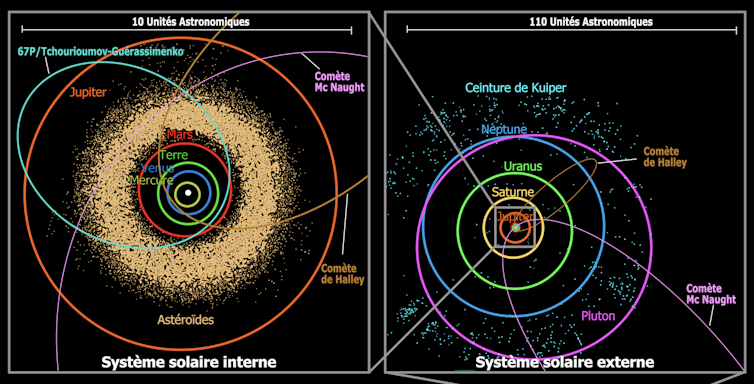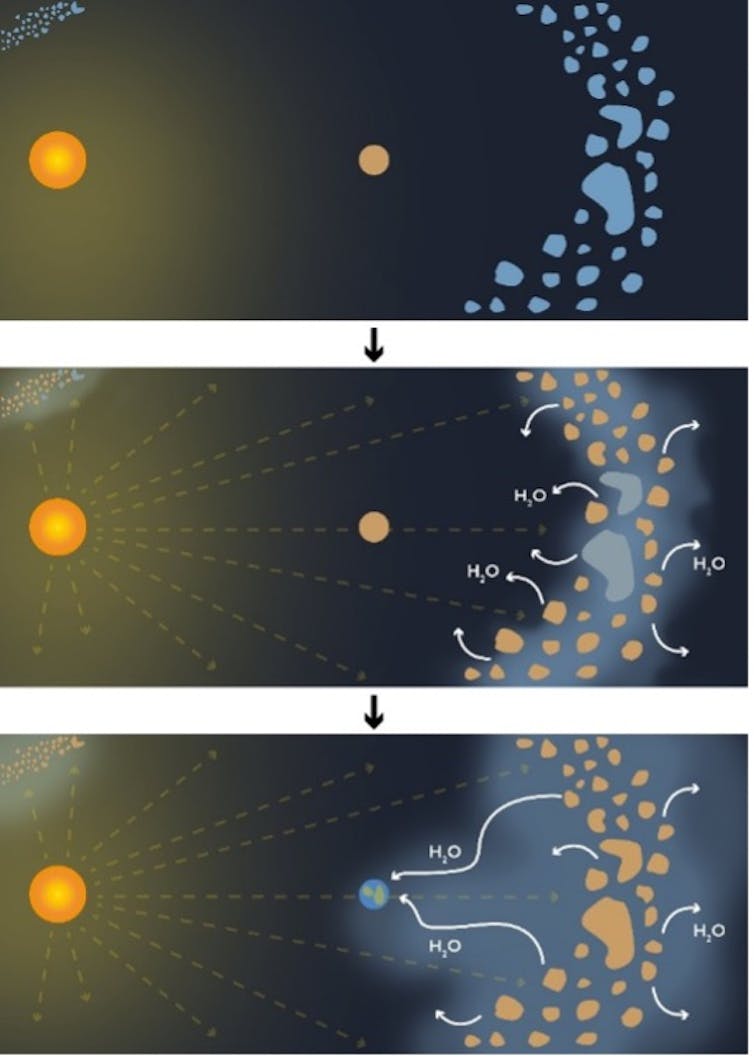When Earth first formed, it was too hot to retain ice. This means all the water on our planet must have originated from extraterrestrial sources.
Studies of ancient terrestrial rocks suggest liquid water existed on Earth as early as 100 million years after the Sun's formation – practically 'immediately' on an astrophysical timescale.
This water, now over 4.5 billion years old, has been perpetually renewed through Earth's water cycle. My research team has recently proposed a new theory to explain how water first arrived on Earth.
A mystery billions of years in the making
Astrophysicists have been grappling with the question of how water arrived on our young planet for decades. One of the earliest hypotheses suggested that Earth's water was a direct byproduct of the planet's formation, released via magma during volcanic eruptions, in which most of the emitted gas is water vapor.
However, this hypothesis evolved in the 1990s following analysis of Earth's water composition and the discovery of the potential role of icy comets, pointing to an extraterrestrial origin.
Comets, which are mixtures of ice and rock formed in the distant reaches of the solar system, are sometimes ejected toward the Sun. When warmed by the Sun, they develop striking tails of dust and gas that are visible from Earth. Asteroids, located in the asteroid belt between Mars and Jupiter, were also proposed as potential progenitors of Earth's water.
The study of cometary and asteroid rocks via meteorites – small fragments of these bodies that have fallen to Earth – has provided key insights.
By analyzing the D/H ratio – the proportion of heavy hydrogen (deuterium) to standard hydrogen – scientists found that Earth's water more closely matches that of 'carbonaceous' asteroids, which bear traces of past water. This shifted the focus of research toward these asteroids.

Recent studies have centered on identifying the celestial mechanisms that could have delivered these water-rich asteroids to the dry surface of early Earth. Numerous theories have emerged to explain the 'perturbation' of planetesimals – large, icy bodies in the asteroid and Kuiper belts.
These scenarios propose gravitational interactions that dislodged these objects, sending them hurtling toward Earth. Such events would have required a complex 'gravitational billiards' process, suggesting a tumultuous history of the Solar System.
While it is evident that planetary formation involved significant upheavals and impacts, it is possible that Earth's water delivery occurred in a more natural and less dramatic manner.
A simpler hypothesis
I started with the assumption that asteroids emerge icy from their formation cocoon, also known as the protoplanetary disk. This cocoon is a massive, hydrogen-rich disk filled with dust, where planets and initial belts form. It envelops the entire nascent planetary system.
Once this protective cocoon dissipates – after a few million years – the asteroids warm up, causing their ice to melt or, more precisely, to sublimate. In space, where pressure is nearly zero, the water remains in vapor form after this process.
A disk of water vapour is then superimposed on the asteroid belt orbiting the Sun. As the ice sublimates, the disk fills with vapor, which spreads inward toward the Sun due to complex dynamic processes. Along the way, this vapor disk encounters the inner planets, immersing them in a kind of 'bath'.
In a way, the disk 'waters' the terrestrial planets: Mars, Earth, Venus and Mercury. Most of this water capture occurred 20 to 30 million years after the Sun's formation, during a period when the Sun's luminosity increased dramatically over a brief period of time, increasing the degassing rate of asteroids.

Once water is captured by a planet's gravitational pull, many processes can occur.
On Earth, however, a protective mechanism ensures the total mass of water has remained relatively constant from the end of the capture period until today. If water rises too high into the atmosphere, it condenses into clouds, which eventually return to the surface as rain–a process known as the water cycle.
The quantities of water on Earth, both past and present, are well documented. Our model, which begins with the degassing of ice from the original asteroid belt, successfully accounts for the amount of water needed to form oceans, rivers and lakes, and even the water buried deep within Earth's mantle.
Precise measurements of the D/H ratio of water in the oceans also align with our model. Moreover, the model explains the quantities of water present in the past on other planets–and even on the Moon.
You might wonder how I arrived at this new theory. It stems from recent observations, particularly those made with ALMA, a radio telescope array of over 60 antennae located in Chile, on a plateau five kilometres above sea level.
Observations of extrasolar systems with belts similar to the Kuiper Belt reveal that planetesimals in these belts sublimate carbon monoxide (CO). For belts closer to their star, such as the asteroid belt, CO is too volatile to be present, and water is more likely to be released.
Building the model
It was from these findings that the initial idea for the theory began to take shape. Moreover, recent data from the Hayabusa 2 and OSIRIS-REx missions, which explored asteroids similar to those that might have contributed to the formation of the initial water vapor disk, provided key confirmation.
These missions, along with long-standing observations from ground-based telescopes, revealed substantial amounts of hydrated minerals on these asteroids–minerals that can only form through contact with water. This supports the premise that these asteroids were initially icy, even though most have since lost their ice (except for larger bodies like Ceres).
With the foundation of the model in place, the next step was to develop a numerical simulation to track the degassing of ice, the dispersion of water vapor, and its eventual capture by planets.
During these simulations, it quickly became clear that the model could account for Earth's water supply. Additional research on past water quantities for Mars and other terrestrial planets confirmed the model's applicability to them as well. It all fit, and the results were ready for publication!
As researchers, it's not enough to design a model that works and seems to explain everything. The theory must be tested on a larger scale. While it's now impossible to detect the initial water vapor disk that 'watered' the terrestrial planets, we can look to extrasolar systems with young asteroid belts to see if such water vapor disks exist.
According to our calculations, these disks, though faint, should be detectable with ALMA. Our team has just secured time on ALMA to investigate specific systems for evidence of them.
We may be at the dawn of a new era in understanding the origins of Earth's water.![]()
Quentin Kral, Astrophysicien à l'observatoire de Paris-PSL, CNRS, Sorbonne Université, Université Paris Cité
This article is republished from The Conversation under a Creative Commons license. Read the original article.
